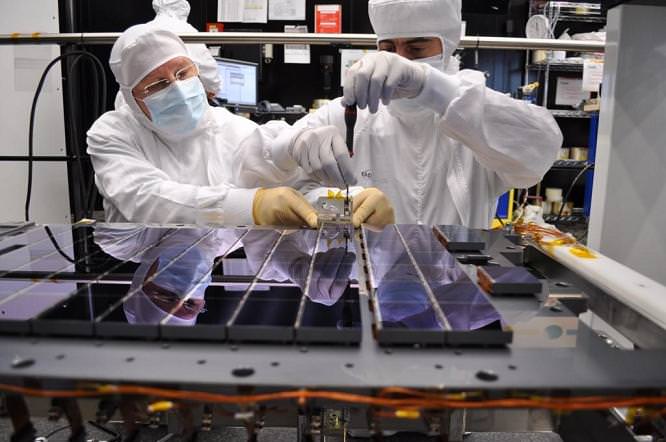In astronomy we throw around the term “light-year” seemingly as fast as light itself travels. And yet actually measuring this distance is incredibly tricky. A star’s parallax — its tiny apparent shift once a year caused by our moving viewpoint on Earth — tells its distance more truly than any other method.
Accurate parallaxes of nearby stars form the base of the entire cosmic distance ladder out to the farthest galaxies. It’s a crucial science that’s about to take a giant leap forward. The European Space Agency’s long-awaited Gaia observatory — launched on Dec. 19, 2013 — is now ready to begin its science mission.
Gaia’s goal is to create the most accurate map yet of the Milky Way. It will pinpoint the locations of one billion stars down to 20th magnitude — nearly one percent of all the stars in the Milky Way galaxy.
“We will … analyze one billion — if not more — stars with the astrometry and photometry instruments, measuring each star’s position and motion up to 100 times more accurately than Gaia’s predecessor Hipparcos and for a far larger number of stars,” said Giuseppe Sarri, ESA’s Gaia Project Manager, in a press release.
Although Gaia’s goal is deceptively simple, it’s impossible to do from ground-based telescopes where the turbulence from Earth’s atmosphere is simply too high. Gaia bypasses this problem by being above the Earth’s atmosphere. It will measure distances to an accuracy of at least 25 microarcseconds. That’s like measuring the apparent width of a human hair in Chicago seen from the distance of New York.
To do this, Gaia will repeatedly scan the sky, observing each of its billion stars an average of 70 times over five years. It will spin slowly once every six hours, sweeping its two telescopes across the sky and focusing the light from their separate fields onto the largest digital camera ever flown in space, with nearly a billion pixels.
As the stars drift across the camera, the relative positions of all detected stars are measured. Over time, a complete network of positions will be built, eventually yielding a highly accurate 3D map.
Gaia is now ready to begin its five-year science phase, but it wouldn’t be a true science mission without a few unexpected glitches.
One problem uncovered early was water freezing on some parts of the optics, causing a temporary reduction in transmission of the telescopes. The water was likely trapped in the spacecraft before launch and emerged once it was in a vacuum. Heating the affected optics to remove the ice largely solved the problem.
Another problem is a higher level of “stray light” reaching Gaia’s camera than predicted before launch. It appears to be a mixture of light from the Sun finding its way past Gaia’s 10 m-diameter sunshield and light from other astronomical objects. This impact should be more significant for any observed faint stars.
“However, we are optimizing the onboard software to mitigate as much as possible the impact caused by these higher background levels of light, and we are confident that we will not be far off our initial and somewhat conservative estimate of studying 150 million stars with [the] radial velocity spectrometer, as planned,” said Sarri.
Finally, Gaia contains a laser device designed to measure the angle of separation between its two telescopes. This is necessary in order to correct for expected periodic variations caused by thermal changes as Gaia spins. Although the system is working, the detected variations are larger than expected, so further efforts will be made to accurately measure the variations.
Nonetheless, tests made during commissioning have shown that Gaia may be able to perform better than expected in some cases. On the one hand, it may be possible to extend Gaia’s reach to stars even fainter than 20th magnitude, while on the other hand, software changes may enable Gaia to measure almost all of the brightest stars in the sky, previously ruled out as being too bright for such a sensitive system.
“The commissioning phase has been challenging, and although some activities are ongoing, all in all Gaia is in good shape to fulfill its promise — all of the core scientific goals are still achievable, as hoped,” said Timo Prusti, ESA’s Project Scientist for Gaia.
You can follow Gaia’s mission and future scientific results on its very own blog.

